ANZINE : CAE 기술 매거진
이전 ANZINE Home Case Study
CASE STUDY Earthquake evaluation of a stacker crane deployed in the Mexican Republic
- Andrea Piazza, Jaqueline Rafaela Travessini
- System Logistics
- andrea.piazza@systemlogistics.com
Earthquake evaluation of a stacker crane deployed in the Mexican Republic
The intralogistics sector uses stacker cranes to transport stacked pallets between racks.
by Andrea Piazza, Jaqueline Rafaela Travessini - System Logistics
■ 이 기고문은 멕시코에 설치된 물류 창고 선반 사이에 적재된 팔레트를 운송하는 스태커 크레인의 내진 스펙트럼 해석에 대한 내용을 다루고 있습니다. 이를 위해 내진 스펙트럼을 정의하고, 정적 구조해석과 응답 스펙트럼 해석을 수행합니다. 이러한 해석을 통해 스태커 크레인과 랙의 안전한 설계를 보장하여 창고 소유자는 안정적인 서비스를 제공할 수 있습니다.
Stacker cranes handle pallet placement in the warehouse, moving longitudinally along the aisles between the warehouse shelves to deposit and retrieve loads. They come in different heights and move along two towing rails, one on the ground and one overhead that is connected to the rack. Stacker cranes are susceptible to earthquakes that can damage them and the racks around them. As an important piece of equipment in the warehouse, any damage they suffer can impact heavily on restoration costs and can interrupt pallet flows causing further economic damage to the warehouse owners.
Each region of the world has different seismic norms that describe how to calculate the seismic load that structures may suffer in that location. These norms are intended to ensure the safety of structures, establish seismic intensity levels, and set minimum requirements for the seismic design of structures. The seismic load specification is based on determining the expected magnitude and intensity of earthquakes and their effect on the terrain at a given site, and converting these in some way into the parameters of ground motion. The stacker crane in this article will be installed in Mexico in seismic zone B.
Seismic load spectrum
A geotechnical study of the terrain in Mexico had been undertaken for the purpose of issuing the necessary recommendations for the design of foundations. The following values were extrapolated from this document:
a0=0.13*981=127.53cm/s2
c=0.326*981=319.8cm/s2
Where a0 is the maximum ground acceleration and c is the design coefficient. Furthermore, according to the geotechnical study, the structure should be classified as Group B, Type 6.
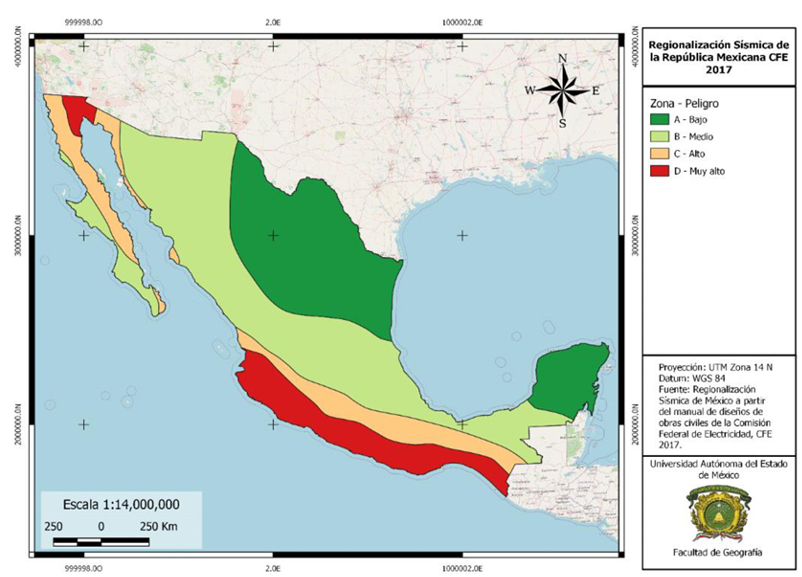
+ Fig. 1. Seismic regions of the Mexican Republic (source: CFE, 2017).
According to the manual the terrain on which the stacker crane operates is classified as Group B – Class 1 – Zone B – Type III, which has the following load spectrum:
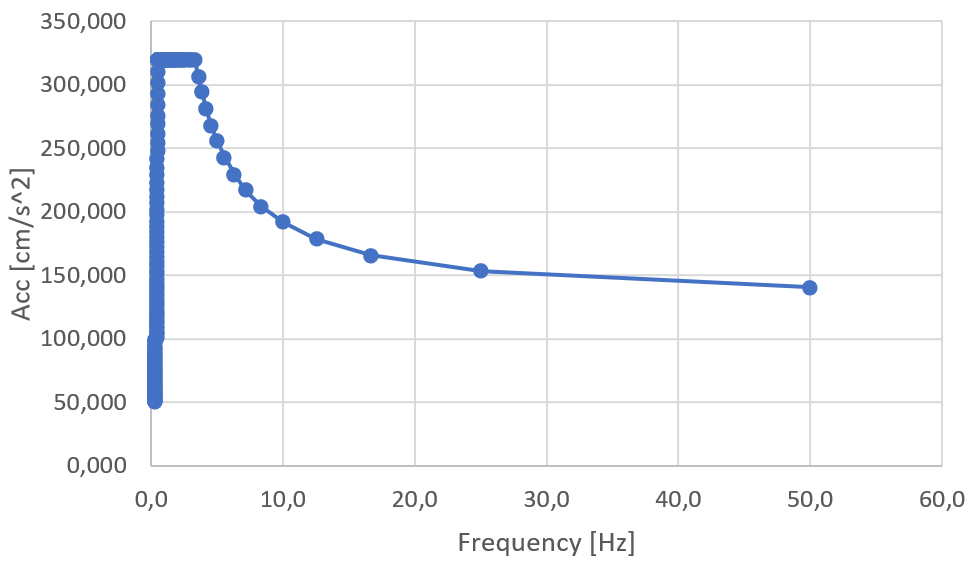
+ Fig. 2. Load Spectrum of terrain - classified as Group B – Class 1 – Zone B – Type III.
Set up of the seismic analysis
The seismic analysis begins with a static structural analysis of the full structure and ends with a response spectrum analysis (RSA), following the workflow shown below:
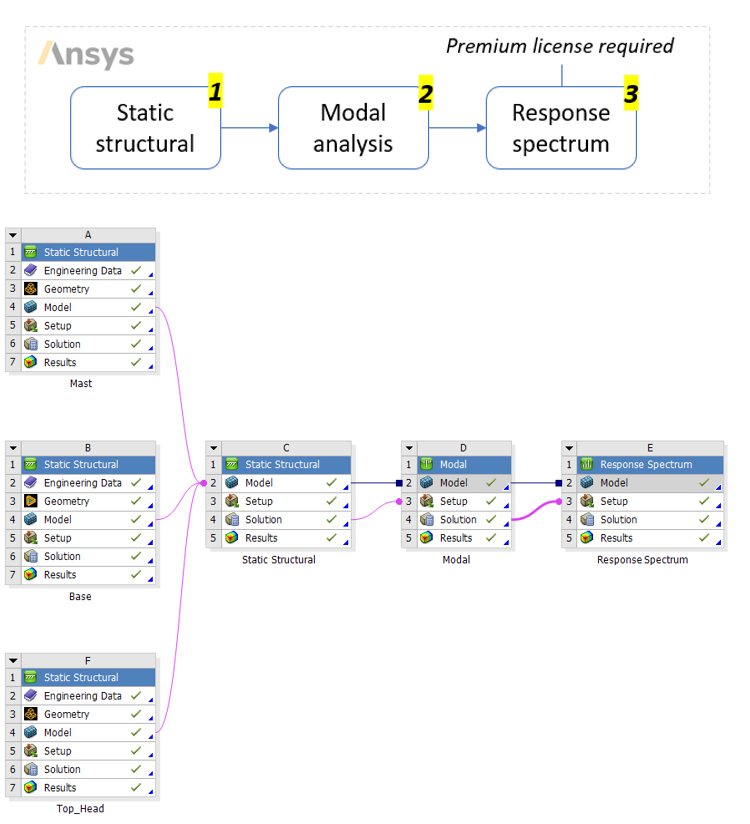
+ Fig. 3. Ansys Workbench workflow.
Static structure
Stacker cranes can reach up to 40m in height and 30 tons in weight. The first step in the workflow is to perform an analysis of the static structure with all its mass points, forces, constraints, at standard earth gravity. The static analysis provides the pre-stress levels and constraints that will influence the modal analysis. The complete 3D model of the piece of equipment is developed, including various details concerning the mast, base, and upper parts.
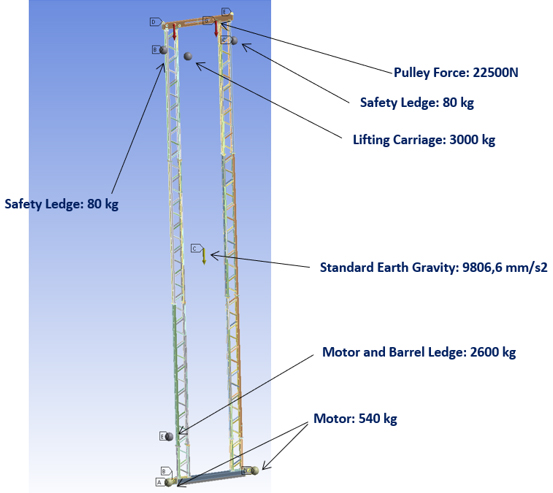
+ Fig. 4. Analysis of the static structure - mass point.
Modal analysis
Modal analysis is a dynamic analysis that generates the natural frequencies at which a structure will resonate. It allows engineers to avoid resonant vibrations or vibrations at a specific frequency and provides information on how the design is likely to respond to different types of dynamic loads. Modal analysis can be performed with or without pre-stress.
Pre-stress modal analysis is a study of the effect of loading on the dynamic response of a structure. Pre-stressing the structure can result in a significant variation in the frequencies of the extracted modal shape, especially at the first mode compared to higher modes.
For the purpose of this study, 45 modal shapes were extracted for the stacker crane, resulting in an effective mass ratio of more than 80% in the X, Y, and Z directions. The modal analysis was performed with pre-stress.
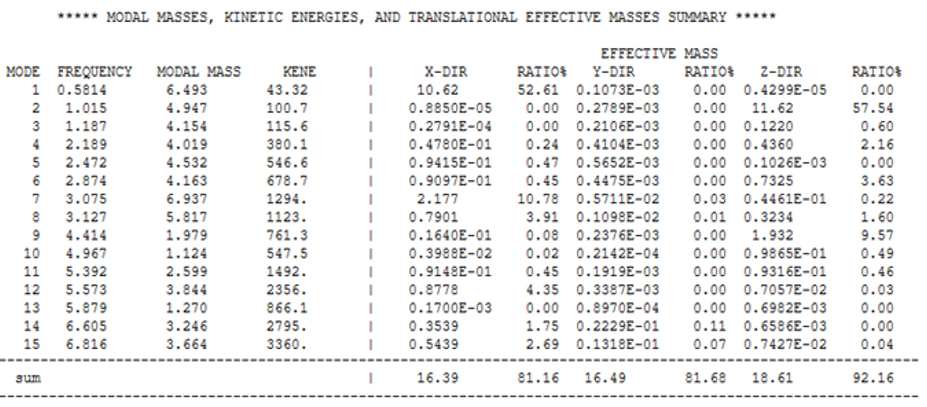
+ Fig. 5. Modal analysis - effective mass.
Response spectrum analysis
A response spectrum analysis calculates the maximum response of a structure to a transient load. It is performed as a rapid alternative to a full transient solution. The load can consist of a displacement, velocity or acceleration. It is possible to apply the same load to all constraints (single point case), or different loads to each constraint (a multi-point case). The response spectrum analysis technique combines the response spectrum of a given dynamic load with the results of the modal analysis. These maximum modal response values are then combined using a method (such as sum of absolute values or complete quadratic combination, CQC) to estimate the peak response of the structure.
For periodic modal responses with sufficiently separate frequencies, the square root of the sum of the squares (SRSS) method is the correct method to combine the modal responses. Where the modes have closely spaced frequencies, various conservative methods such as complete quadratic combination (CQC) and Rosenblueth (ROSE) can be used to combine the modal responses - the SRSS method is not suitable in this case.
The definition of modes with closely spaced frequencies is a function of the critical damping ratio. At critical damping ratios ≤2%, modes are considered closely spaced if their frequencies are within 10% of each other (i.e. for fi < fj, fj ≤ 1.1 fi). At critical damping ratios >2%, modes are considered closely spaced if their frequencies are within five times of each other’s critical damping ratio
(i.e. for fi < fj and 5% damping, fj ≤ 1.25 fi; for fi < fj and 10% damping, fj ≤ 1.5 fi).
+ Table 1. Closely-spaced frequency verification.
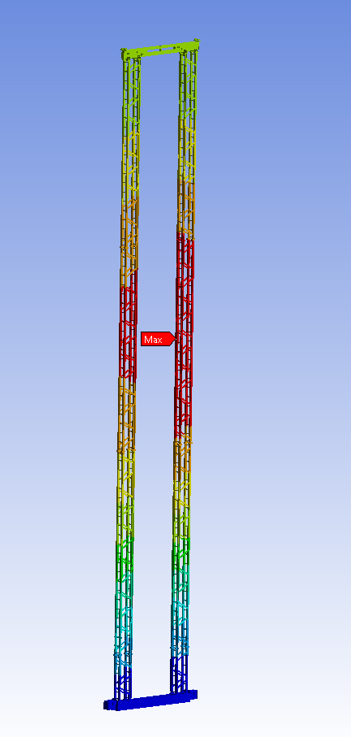
+ Fig. 6. Deformation RSA.
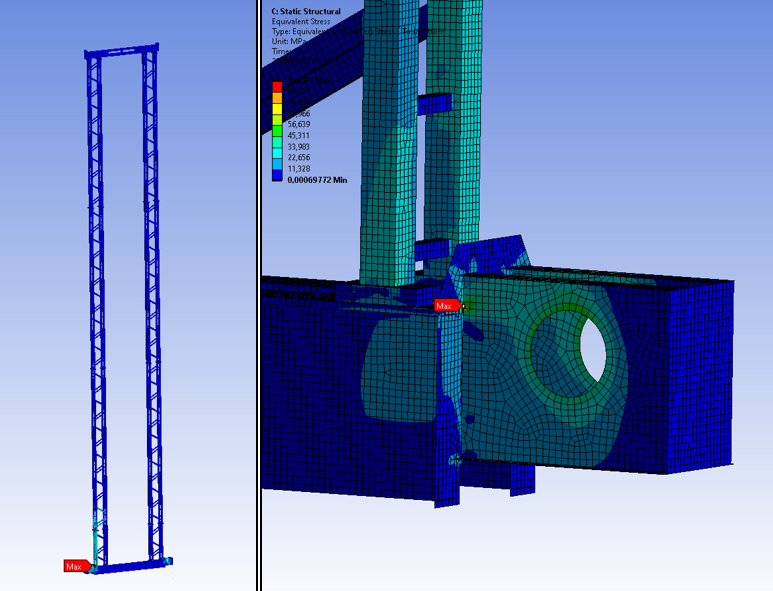
+ Fig. 7. Equivalent stress and maximum stress.

+ Fig. 8. Reaction force – upper wheels.
Since there are many closely spaced frequencies, the SRSS method is not applicable in this case. The ROSE method, which offers a mathematical approach to modal correlation evaluation for seismic response spectrum analysis, was chosen to evaluate the displacement, stress, and reaction forces of the model.
RSA reaction forces
The RSA results allow the reaction forces to be calculated and considered by the designers of the complete rack structure. According to the RSA analysis, the reaction forces on the upper wheels of the stacker crane are: A: 7733,7 N; B: 10478 N
Conclusion
Simulation procedure, as shown, allows a safe and reliable design of stacker crane fully integrated in a whole warehouse system. Risk related to seismic occurrences is drastically reduced and evaluated. It was possible to analyse the results in terms of the stress and reaction forces and to verify that they are compliant with System Logistics standards.
At the given maximum acceleration of 0.13g, the stacker crane’s maximum stress does not reach critical values, having a safety factor of 1.53. Consider the crane is 38.5 meters high, the deformation of 54mm only accounts for 0.14% of the total height, which is also acceptable.
The response analysis enables both the stacker crane and the rack to be correctly dimensioned, guaranteeing optimal safety for the warehouse and helping the manufacturers of both the stacker crane and the rack to deliver a better product to the customer.
References
[1] Seismic regions of the Mexican Republic (source: CFE, 2017).
For more information: Andrea Piazza – System Logistics; andrea.piazza@systemlogistics.com
About System Logistics
System Logistics is a leading global supplier of innovative intralogistics and material handling solutions to optimize operations in warehouses, distribution centres, and manufacturing supply chains worldwide. With a special focus on the Food & Beverage and Grocery sectors, System Logistics develops tailor-made solutions for automated storage and picking, including stacker cranes, material handling equipment, software, and services. Most of the technologies we use in our solutions are fully engineered, developed, and manufactured in-house and are then also installed by System Logistics. This gives us complete control of the process. We are a dependable, long-term partner: collaborating closely with our customers, we develop flexible solutions that address the challenges they face every day and that will grow and change with them in the future.








 ㈜태성에스엔이
㈜태성에스엔이


